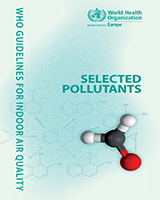All rights reserved. The Regional Office for Europe of the World Health Organization welcomes requests for permission to reproduce or translate its publications, in part or in full. Address requests for publications of the WHO Regional Office for Europe to: Publications, WHO Regional Office for Europe, Scherfigsvej 8, DK-2100 Copenhagen Ø, Denmark. Alternatively, complete an online request form for documentation, health information, or for permission to quote or translate, on the Regional Office web site (http://www.euro.who.int/pubrequest).
NCBI Bookshelf. A service of the National Library of Medicine, National Institutes of Health.
Abstract
This book presents WHO guidelines for the protection of public health from risks due to a number of chemicals commonly present in indoor air. The substances considered in this review, i.e. benzene, carbon monoxide, formaldehyde, naphthalene, nitrogen dioxide, polycyclic aromatic hydrocarbons (especially benzo[a]pyrene), radon, trichloroethylene and tetrachloroethylene, have indoor sources, are known in respect of their hazardousness to health and are often found indoors in concentrations of health concern. The guidelines are targeted at public health professionals involved in preventing health risks of environmental exposures, as well as specialists and authorities involved in the design and use of buildings, indoor materials and products. They provide a scientific basis for legally enforceable standards.
Contents
- Contributors
- Acknowledgements
- Foreword
- Executive summary
- Introduction
- 1. BenzeneRoy Harrison, Juana M. Delgado Saborit, Frédéric Dor, and Rogene Henderson.
- 2. Carbon monoxideDavid Penney, Vernon Benignus, Stylianos Kephalopoulos, Dimitrios Kotzias, Michael Kleinman, and Agnes Verrier.
- 3. FormaldehydeDebra A. Kaden, Corinne Mandin, Gunnar D. Nielsen, and Peder Wolkoff.
- 4. NaphthaleneAlan Buckpitt, Stylianos Kephalopoulos, Kimmo Koistinen, Dimitrios Kotzias, Lidia Morawska, and Helmut Sagunski.
- 5. Nitrogen dioxideDebbie J. Jarvis, Gary Adamkiewicz, Marie-Eve Heroux, Regula Rapp, and Frank J. Kelly.
- 6. Polycyclic aromatic hydrocarbonsHyunok Choi, Roy Harrison, Hannu Komulainen, and Juana M. Delgado Saborit.
- 7. RadonMichaela Kreuzer and James McLaughlin.
- 8. TrichloroethyleneNathalie Bonvallot, Paul Harrison, and Miranda Loh.
- 9. TetrachloroethyleneNicole Nijhuis, Miranda Loh, and Paul Harrison.
The designations employed and the presentation of the material in this publication do not imply the expression of any opinion whatsoever on the part of the World Health Organization concerning the legal status of any country, territory, city or area or of its authorities, or concerning the delimitation of its frontiers or boundaries. Dotted lines on maps represent approximate border lines for which there may not yet be full agreement.
The mention of specific companies or of certain manufacturers' products does not imply that they are endorsed or recommended by the World Health Organization in preference to others of a similar nature that are not mentioned. Errors and omissions excepted, the names of proprietary products are distinguished by initial capital letters.
All reasonable precautions have been taken by the World Health Organization to verify the information contained in this publication. However, the published material is being distributed without warranty of any kind, either express or implied. The responsibility for the interpretation and use of the material lies with the reader. In no event shall the World Health Organization be liable for damages arising from its use. The views expressed by authors, editors, or expert groups do not necessarily represent the decisions or the stated policy of the World Health Organization.
- NLM CatalogRelated NLM Catalog Entries
- Personal and ambient exposures to air toxics in Camden, New Jersey.[Res Rep Health Eff Inst. 2011]Personal and ambient exposures to air toxics in Camden, New Jersey.Lioy PJ, Fan Z, Zhang J, Georgopoulos P, Wang SW, Ohman-Strickland P, Wu X, Zhu X, Harrington J, Tang X, et al. Res Rep Health Eff Inst. 2011 Aug; (160):3-127; discussion 129-51.
- Carcinogenic potential, levels and sources of polycyclic aromatic hydrocarbon mixtures in indoor and outdoor environments and their implications for air quality standards.[Environ Int. 2011]Carcinogenic potential, levels and sources of polycyclic aromatic hydrocarbon mixtures in indoor and outdoor environments and their implications for air quality standards.Delgado-Saborit JM, Stark C, Harrison RM. Environ Int. 2011 Feb; 37(2):383-92. Epub 2010 Dec 10.
- Review [Pollution of confined air in non-industrial environments].[Ann Ig. 1989]Review [Pollution of confined air in non-industrial environments].Melino C, Pasquarella A, De Luca D'Alessandro E. Ann Ig. 1989 May-Aug; 1(3-4):459-80.
- Organic air pollutants inside and outside residences in Shimizu, Japan: levels, sources and risks.[Sci Total Environ. 2006]Organic air pollutants inside and outside residences in Shimizu, Japan: levels, sources and risks.Ohura T, Amagai T, Senga Y, Fusaya M. Sci Total Environ. 2006 Aug 1; 366(2-3):485-99. Epub 2005 Nov 18.
- Review Health effects and sources of indoor air pollution. Part I.[Am Rev Respir Dis. 1987]Review Health effects and sources of indoor air pollution. Part I.Samet JM, Marbury MC, Spengler JD. Am Rev Respir Dis. 1987 Dec; 136(6):1486-508.
- WHO Guidelines for Indoor Air Quality: Selected PollutantsWHO Guidelines for Indoor Air Quality: Selected Pollutants
Your browsing activity is empty.
Activity recording is turned off.
See more...
